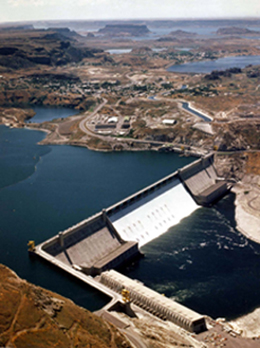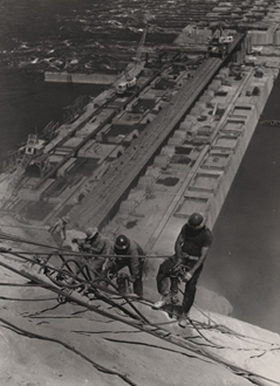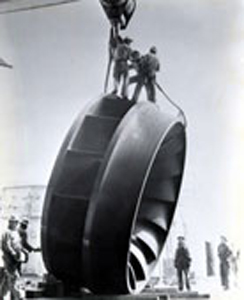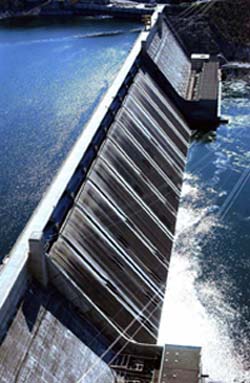
Grand Coulee Dam, on the Columbia River west of Spokane, Washington, is one of the largest structures ever built by mankind--a mass of concrete standing 550 feet high and 5,223 feet long, or just shy of a mile. Grand Coulee contains 12 million cubic yards of concrete, or enough to build a highway from Seattle to Miami. More massive than the Great Pyramid of Giza, Grand Coulee is listed by the American Society of Civil Engineers as one of the seven civil engineering wonders of the United States. Grand Coulee's reservoir, Franklin D. Roosevelt Lake, stretches 150 miles north, almost to the Canadian border.
A concrete gravity dam, Grand Coulee took eight years to build, employed thousands of men during the Great Depression and, when completed in 1942, provided the enormous electrical power necessary to make aluminum, so essential for World War II production of planes and ships. It was Grand Coulee, as well, that powered the production of plutonium at the nearby Hanford Site, which figured prominently in the making of the atomic bomb.
So grand was Grand Coulee Dam that in 1941 folk singer Woody Guthrie wrote “The Song of the Grand Coulee Dam” (though he was paid to do so under contract with the Bonneville Power Administration.) “Biggest thing built by the hand of a Man,” Guthrie sang. “Power that sings, boys, turbines that whine. Waters back up the Canadian Line.”
Appropriate as the word grand is for the dam, the name Grand Coulee actually refers to a unique geological feature created thousands of years ago when Ice Age glaciers blocked the ancient riverbed of the Columbia River. When water eventually traveled under the ice dam, great floods scoured out hundreds of miles of deep gulches, or coulees, in the Columbia River Basin. One of these, the Grand Coulee, is four miles wide and bordered on three sides by steep cliffs.
A local proposal to dam the Columbia at the head of the Grand Coulee dated to 1918, but the idea faced strong competition from another proposal that called for an irrigation canal to be built from the Pend Oreille River in northern Idaho. Proponents of this latter “gravity plan” argued that the hydroelectricity generated from the dam was not needed. Many studies followed, including one by the U.S. Army Corps of Engineers, which took Grand Coulee’s side, recommending a high dam at the site and the pumping of irrigation water up to the surrounding countryside.
This recommendation took hold with the Bureau of Reclamation, which was promoting construction of multiple-use dams, through which the production of hydroelectric power could produce revenue to help repay the construction cost of a project. (The Reclamation Act requires that beneficiaries of a project repay those costs, and a multi-purpose project reduced the payment burden on irrigators.) The recommendation found traction with the 1932 election of Franklin D. Roosevelt, who took office in a time of great dust bowls and economic depression. Roosevelt launched Federal program after Federal program in an attempt to spur the economy by “priming the pump” and providing jobs for out-of-work Americans. Unprecedented funds flowed to the Bureau of Reclamation as it became a key player in the New Deal’s Public Works Administration (PWA), which spent “big bucks on big projects,” Grand Coulee Dam among them.

Groundbreaking ceremonies took place on July 16, 1933, just days before funds were approved for another dam on the Columbia River--the huge Bonneville Dam, to be built downstream by the Corps of Engineers. Many other dams would follow on the Columbia, which traces its headwaters to the Canadian Rockies. The river crosses into the United States in eastern Washington and flows 400 miles through the state before taking a big turn west, forming the border with Oregon as it heads toward the Pacific Ocean.
Originally, Grand Coulee was to be a low dam (with plans to raise it higher at a later time). The contract for a low dam, awarded on July 13, 1934, went to the Mason-Walsh-Atkinson-Kier Company (MWAK). They quickly set about designing and building Mason City, touted as the world’s first “all electric city,” to house workers. Other towns sprang up, including Engineers Town, built by Reclamation to house its engineers, and the rowdy Grand Coulee, known for its taverns and gambling halls.
From the town of Odair, rails extended to the construction site, where MWAK used an innovative conveyor belt, rather than trucks, to carry the tons of rock and earth excavated each day. Meanwhile, at Reclamation’s experimental laboratory in Colorado, engineers tested different plans for diverting the Columbia so construction could begin. The selected design, William Joe Simonds writes, was a 3,000-foot-long, U-shaped, steel pile coffer dam, one for the river’s west side and one for the east, containing interlocking cells that were filled with rock and earth from the excavations. The dam, as well, was to be built in two sections--west and east.
Technical problems associated with plans to raise the low dam at a later date, as well as the low dam’s use for power only, led, in June 1935, to the decision to make Grand Coulee a high dam. That summer MWAK constructed two cement plants, one for each side of the dam, capable of producing 640 cubic yards (or 129,338 gallons) of concrete every hour. As workers excavated, exposing the bedrock foundation for the dam, others drilled test holes from 30 to 200 feet deep. Then, men were lowered into the holes to inspect the quality of the rock. Twenty to 30-foot deep grout holes also were drilled; the grout pumped in to provide a secure seal beneath the dam.
Concrete placement began in the fall of 1935 but, as winter set in, the air turned so cold that several concrete pours actually froze and had to be blasted away and replaced. In January, concrete work halted altogether until spring, when it picked up again, only to halt again the next winter, then pick up in the spring and summer at ever increasing speeds, setting several records for concrete placement. “MWAK’s record was remarkable,” Simonds writes. Nearly 11,000 men worked more than 27 million hours to divert the river, excavate the foundation, and place concrete. Forty-five workers died in the process.

On May 12, 1938, Reclamation received the completed foundation from MWAK, and a new contract was issued to Consolidated Builders Inc. (CBI) of Oakland, Calif., whose job it was to complete the dam to its full height of 550 feet and build the Left Powerhouse. (The company had changed its name from Interior Construction at the orders of the Interior Department.) As CBI took over concrete work, Coulee stood an average of 177 feet above the bedrock. Numerous subcontractors performed other tasks, including the Western Pipe and Steel Company of California, which contracted with Reclamation to manufacture and install the dam’s mammoth penstocks, which are pipes that carry water through the dam to operate the turbines that produce hydroelectric power. Measuring 18 feet in diameter, Grand Coulee’s original 18 penstocks were so huge they had to be fabricated onsite, in a building as long as a football field. Sixteen million pounds of steel were shipped in from the Midwest and South, the mills transporting the steel in semi-circular rolls so it could fit through rail yards and tunnels along the way. The Assembly Building, the building used to fabricate the penstocks, is still standing.
As the dam rose block by block from its bedrock foundation, construction proceeded on its two powerhouses and a pump station that one day would send irrigation water up the hillside to project lands. Like MWAK, CBI struggled with the cold in winter, as well as the heat produced as the concrete cured. In a process first used at Owyhee Dam in Oregon and also at Hoover Dam, more than 2,000 miles of one-inch cooling pipes were embedded in Coulee to carry away the heat generated during the concrete curing process and prevent cracking. By April 1939, more than 5,500 men were employed placing concrete. At one point in May, crews worked non-stop for 24 hours, placing an average of one cubic yard (202 gallons) of concrete every four seconds, setting a record. In September 1939, CBI placed 400,000 cubic yards of concrete, breaking a previous record set by MWAK.
The contract for the first three, 108,000 kilowatt generators at Grand Coulee went to Westinghouse at a cost of about $2.6 million each. At the time, the generators were the largest ever constructed. The turbines, built by Newport News Ship Building and Dry Dock Company, also were a record size. On October 4, 1941--just two months before America’s entry into World War II, Coulee’s first generator was placed into service. On December 12, CBI announced that the last concrete had been placed and, on January 1, 1942, Reclamation accepted the dam from CBI.
The irrigation benefits of Grand Coulee would have to wait because the pumps were not installed and all of the dam’s power was required for wartime production to defeat the Axis Powers. The dam’s second and third generators were in service by April 7, 1942, and completion of the next six units was given high priority. So urgent were wartime needs that Reclamation looked to the unfinished Shasta Dam in California for help. Because two of Shasta’s 75,000 kilowatt generators were in storage, awaiting completion of the dam, Reclamation decided to use them temporarily at Coulee, even though Shasta’s generators were designed to rotate counter-clockwise, while Coulee’s turned clockwise. Reclamation solved the problem by adapting Coulee’s generator pits and rerouting the penstocks. Shasta’s generators went into service in February and May 1943.

Grand Coulee played an important role in America’s amazing rollout of warplanes and ships. Coulee powered the Boeing Aircraft Works near Seattle and shipyards in Vancouver, Washington, and Portland, Oregon. Airplanes required aluminum, and by war’s end, Grand Coulee was playing a huge part in a Pacific Northwest that produced more than one-third of the nation’s aluminum. The achievement is even more remarkable considering that in 1940, as Simonds notes, the region had no aluminum-manufacturing capabilities.
With the end of World War II, the economy in the Northwest continued to boom. Water pumped from Grand Coulee began reaching Columbia Basin lands in 1948 and today irrigates about 670,000 acres, although the project was designed to deliver a full water supply to 1.1 million acres. In a region once used only for dry land farming and livestock grazing, crops grown today range from forage and cereal grains to fruit, vegetables, and specialty crops such as mint and wine grapes.
In 1967, construction began on the massive, 20-story-high, Third Powerplant, and today Grand Coulee is the largest hydropower producer in the United States, producing 21 billion kilowatt hours of electricity a year, or about 11 percent of the power requirements of the Pacific Northwest. Grand Coulee still ranks among the largest dams and top producers of electricity in the world, although it has been eclipsed in recent years by dams such China’s Three Gorges Dam on the Yangtze River, which has been criticized for its impacts on people and the ecosystem. Grand Coulee also has faced criticism, most notably for its impact on West Coast salmon and steelhead populations.
Visit the National Park Service Travel Bureau of Reclamation's Historic Water Projects to learn more about dams and powerplants.
Last updated: January 13, 2017
